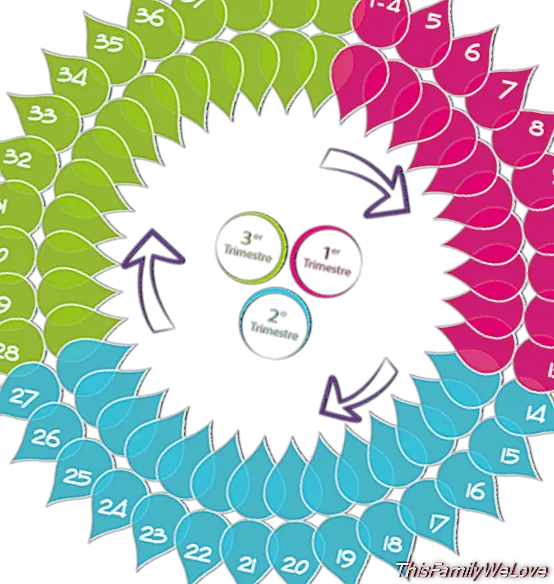Week 40. Pregnancy week by week
Changes in the pregnant woman: week 40 of pregnancy
We began this 40th week of pregnancy as we finished the 39th, with special attention and remembering the Pre-delivery symptoms:
1. Rhythmic, regular contractions (every 5 minutes) and even painful.
2. Bleeding greater than or equal to menstruation.
3. Breaking the bag or amniotic sac (The amniotic fluid can come out in more or less abundant amounts). It is important that you notice the color and appearance of your amniotic fluid. If the liquid is transparent, everything goes well, however if it has a yellowish or greenish color it is urgent that you communicate it to your doctor.
Although it is not known exactly what produces childbirth, it is known that the fundamental role is played by a hormone: oxytocin. When the baby's lungs are mature, they secrete a protein into the amniotic fluid that disrupts the production of hormones. This change causes the placenta to reduce the emission of progesterone and instead promotes the production of oxytocin, which regulates contractions of the uterus.
Development of the baby in week 40 of pregnancy
 Photo: THINSTOCK Enlarge photo
Photo: THINSTOCK Enlarge photoAlthough the size of the babies varies, especially according to their sex, it is considered that the baby in the 40th week of pregnancy weighs between 3 and 4 kilos and measures just over 50 cm. In any case, the doctors consider how optimal weight 3,000 - 3,500 grams.
Surely your baby is 96% born head down, in the so-called cephalic position. If not, it is most likely that you perform a cesarean section (the fetus is removed from the mother's belly through an incision in the abdominal and uterine wall), which in principle does not involve complications except a longer postpartum recovery.
At birth, your baby:
1. It has a more purple color pulling to pinkish or yellow. Her skin is still covered by the remains of vernix caseosa, lanugo and some blood, especially between the folds of her skin.
2. It will have long hair and nails.
3. Your head may be somewhat deformed, since the bones of his skull were separated to facilitate the exit through the birth canal.
4. You will continue to receive antibodies through your breast milk.
5. You will be confused and somewhat stunned. Nothing else to be born will cry (which will fill your lungs with air for the first time) and then adopt a more calm attitude of rest.
6. It has some primary reflections and can perceive lights and shadows and some nearby objects.
As soon as you are born, your baby will be submitted to the call Apgar test, in which it will be scored twice (with an interval of five minutes between test and test) its vital state and health.
The health of the pregnant woman at week 40 of pregnancy
 Photo: THINSTOCK Enlarge photo
Photo: THINSTOCK Enlarge photoAt this time it is normal that intercal many emotions, both positive and negative: impatience, fear and even anxiety about the arrival of the baby but at the same time a lot of illusion. The best thing is that you share all your wishes and fears with family and friends, as well as ask any questions you have to the doctor. Especially in the case that you are new, knowing how the part develops and what happens in the following hours will help you manage your nerves.
Although the normal thing is that fatigue and other discomfort (tightness in the gut, discomfort, lack of sleep, pain in the pelvic floor ...) make you are wishing that the baby is born, enjoy the moment of delivery as you can . It's time to pto put into practice everything you learned in the course of preparation for childbirth, especially, relaxation and breathing techniques.
Finally, and as regards food, it is possible that in this last week of pregnancy you have more cravings. You can eat between meals but always healthy appetizers and snacks that give you energy. For the rest, it continues to consume two liters of water per day Y doing five small meals a day instead of 2 or 3 much more abundant.
Control of pregnancy at week 40 of pregnancy
In week 40 of pregnancy, following the protocol of the SEGO (Spanish Society of Gynecology and Obstetrics) will perform a basal test as part of fetal monitoring. It is a simple, easy to do and uncomplicated method for the mother and her child that will allow to know the heart rate of the baby. If the test shows signs of loss of fetal well-being or in the event that your baby may suffer fetal distress, you will be admitted to end the pregnancy, either by inducing labor or by performing a cesarean section. Another option is the No Stress Test (TSE) By means of which, by placing tapes and sensors on the woman's abdomen, the doctor will also be able to know the baby's heart rate and the contractions of the pregnant woman.
In the meantime, they will make a exploration to see how the cervix is changing. If you are very dilated you will be admitted to the hospital to give birth so that when your uterus reaches 10 centimeters you can be taken directly to the delivery room.
It may be that your baby is not born until one or two weeks later. In this case, your gynecologist and the medical team that treats you will perform tests every few days to determine the status of the placenta and if your baby is receiving adequate nutrition and oxygenation.
Pregnancy calendar week to week
Click on each petal or circle to see the content of your week or trimester of pregnancy respectively.





